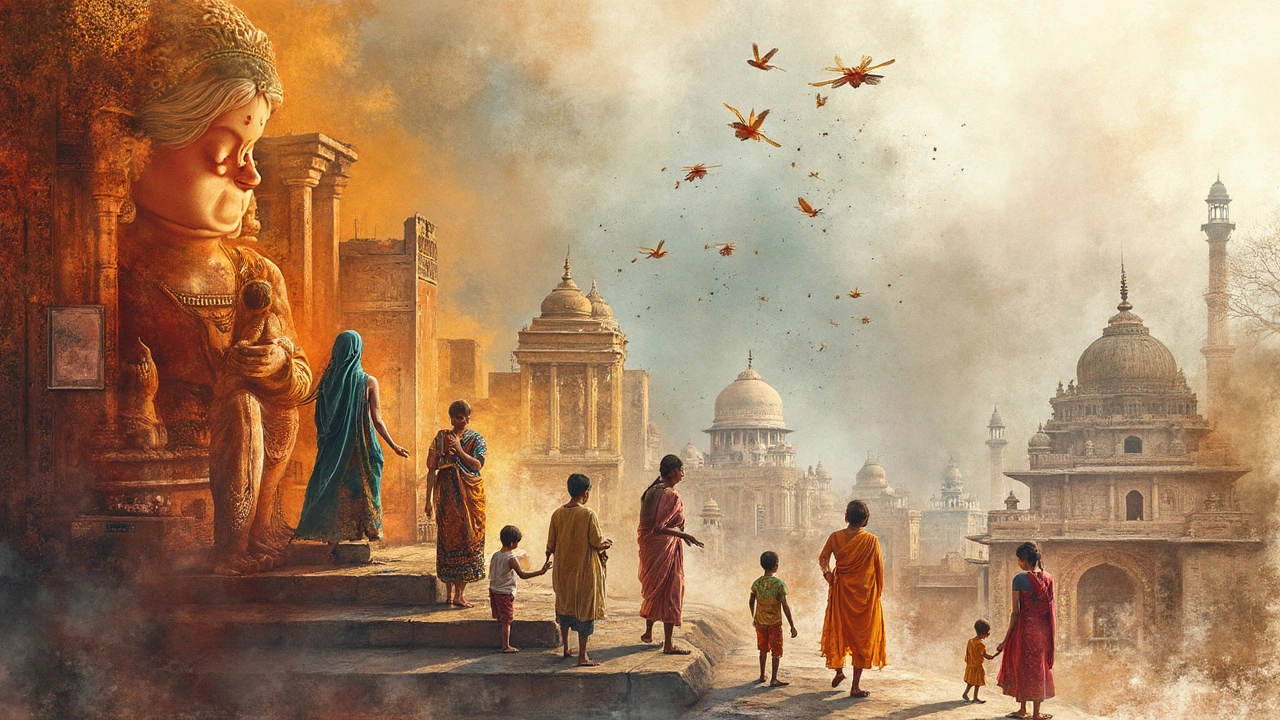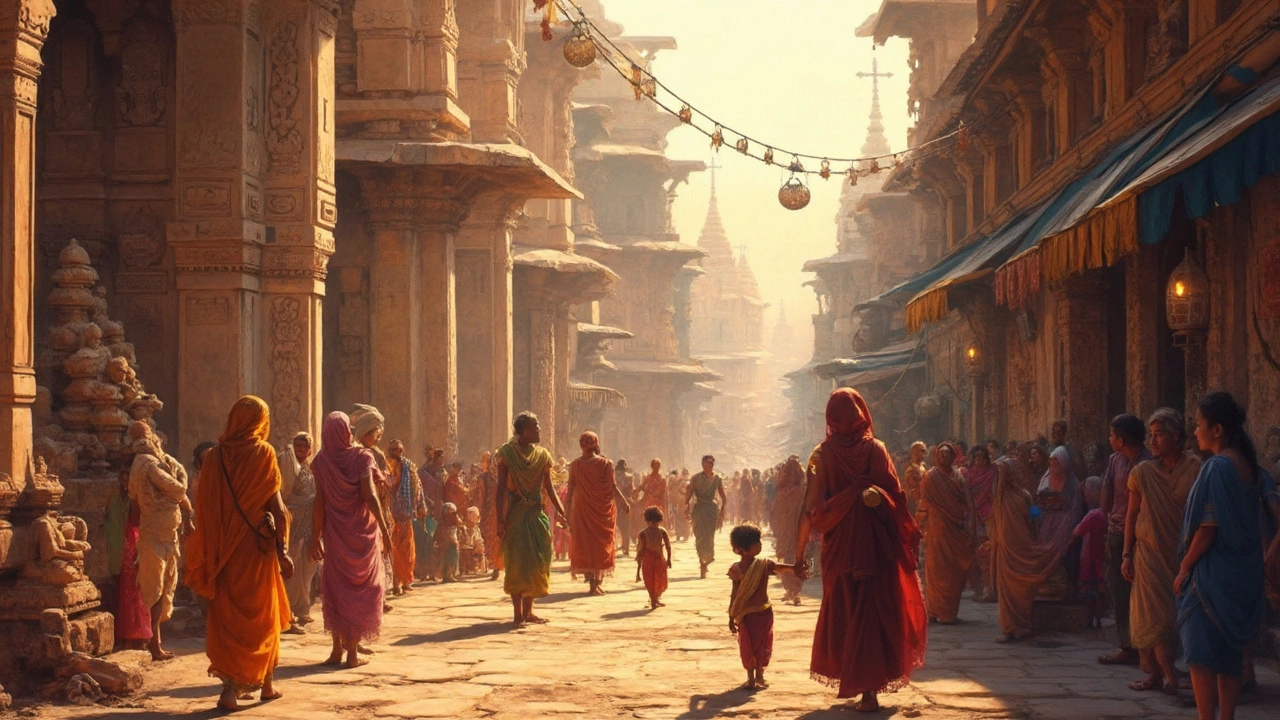Ancient Indian art isn’t just old stuff tucked away in a museum—it’s everywhere, if you look close enough. Step inside a centuries-old temple, check out the carvings on the pillars, or even glance at the patterns on a handwoven sari. These visuals are loaded with meaning. They record achievements, pass down beliefs, and reflect what people valued in their day-to-day lives.
Why care about it now? Ancient art gives clues about how people thought, worshipped, laughed, and worked. It’s like finding a handwritten note from the past—one that doesn’t just tell you facts, but shows you how ideas moved from one generation to another. If you understand why folks painted certain gods on their walls or used particular symbols, you get a front-row seat to history’s actual heartbeat.
- Why Ancient Indian Art Is a Goldmine of Insights
- What Ancient Art Reveals About Culture and Beliefs
- Everyday Tips: Reading Stories in Ancient Artworks
- How Ancient Styles Keep Shaping Modern India
Why Ancient Indian Art Is a Goldmine of Insights
It’s easy to take ancient Indian art for granted, but look closer and you’ll realize it’s packed with stories and facts you won’t find in textbooks. Have you ever walked by an old temple gopuram loaded with sculptures? Those carvings aren’t just for show—they’re history frozen in stone. You can spot what people wore, what they ate, even the kinds of animals that roamed around centuries ago. If you think about ancient Indian art as a super-detailed photo album, you get why it’s a goldmine for anyone curious about how things actually were.
Let’s get concrete. Ever heard of the Ajanta caves? Dating back to the 2nd century BCE, their wall paintings show you scenes from everyday life: markets, music, and temple rituals. It’s rare to get this kind of detail from that far back, so these paintings are a real-life cheat code for researchers. Or take the Chola bronze statues—their incredible craftsmanship tells you not only about religious beliefs, but also about ancient metalwork skills that are tough to beat even with today’s tech.
Here’s something you might not know. Archaeologists often use ancient Indian art to fill gaps in written history. Sometimes, those old scripts are half-erased or super vague, but the carvings and paintings give extra details. For example, the Indus Valley’s famous "Dancing Girl" bronze, dating around 2500 BCE, was a wake-up call—the people back then enjoyed music and dance, not just farming and trading.
| Site | What It Tells Us |
|---|---|
| Ajanta Caves | Social life, styles of dress, music and dance in ancient India |
| Khajuraho Temples | Beliefs, family life, and even regional wildlife |
| Ellora Caves | Religious diversity—Buddhist, Hindu, and Jain influences together |
So, ancient Indian art isn’t just about ‘what’ people created, it’s about ‘why’ and ‘how’ they lived. If you’re interested in food, fashion, or technology from the past, you can actually piece it together by looking at what’s left behind on ancient walls and statues. Next time you spot a centuries-old mural or motif, remember: you’re looking at more than decoration. You’re staring at real-life clues from the folks who came long before us.
What Ancient Art Reveals About Culture and Beliefs
Look at a wall painting in Ajanta or a carving in a temple in Karnataka—they do way more than decorate space. These pieces of ancient indian art actually show how people saw the world and what mattered most to them. For instance, gods and goddesses appear everywhere in frescos, statues, and even coins; that’s how art made big spiritual ideas easy to connect with in daily life.
Ever noticed the same lotus flower popping up again and again? That’s no accident. The lotus stands for beauty and spiritual growth in many Hindu, Buddhist, and Jain works. Elephants, too, aren’t just pretty—they’re all about royalty, strength, and even luck. Ancient indian art packs these symbols in for a reason, practically listing out society’s values right there for anyone to see.
Ancient artists didn’t just follow rules—they bent them to send messages. You’ll find kings painted bigger than their courtiers, letting everyone know who’s in charge. Or maybe you’ll see temple walls telling the whole story of the Ramayana, scene by scene, so even someone who couldn’t read could get the gist just by looking around. Talk about accessible storytelling!
- Ajanta Caves: Famous for Buddhist murals showing everyday life mixed with tales about the Buddha. These paintings highlight how religion guided daily routines and inspired kindness or sacrifice.
- Khajuraho Temples: Known for bold, detailed sculptures that talk about love, relationships, and even taboo topics with zero shame—showing a surprisingly open-minded culture for its time.
- Mughal Miniatures: These tiny, colorful paintings often show royal courts, hunting scenes, and “hidden life” details—giving a snapshot of what the Mughal elite did for both power and fun.
Here’s a quick look at the variety you’ll spot in ancient indian art and what they focus on:
| Art Form | Main Focus |
|---|---|
| Temple Carvings | Religion, myths, social ranks |
| Miniature Paintings | Power, romance, history |
| Folk Art (like Warli) | Nature, daily chores, community events |
You don’t need a degree to start spotting all this stuff. Next time you’re at a temple or museum, look for the odd details—big heads, repeated animals, or stories told in pictures. You’ll start to see just how much ancient indian art was about passing down who we are and what we dream of, one carving or brushstroke at a time.

Everyday Tips: Reading Stories in Ancient Artworks
If you want to really get the hang of ancient indian art, it's all about looking beneath the surface. Ancient Indian sculptures, frescoes, and carvings are packed with clues. You just have to spot what’s what. Let’s break down how you can read those stories, even if you’re new to art history.
- Look at gestures and postures: Hindu deities aren’t just standing around—they’re striking poses called “mudras.” Each mudra means something. For example, an open palm outward (abhaya mudra) means "don’t be afraid," a sign of protection. Spotting these hand signs gives you instant hints about the message.
- Zoom in on the context: See the background? Temples in South India often show scenes from the Ramayana or Mahabharata carved along the walls. Ask a local guide, or just match what you see with pictures or comics you know. You’ll catch references to battles, weddings, and wild adventures.
- Pick out the animals: Those animals aren’t just decorative. Elephants stand for strength and wisdom; peacocks mean beauty and rain. Even tiny details count. Ancient Indian art often uses animals to represent values or tell parts of a bigger story.
- Notice the materials: Think about the stone, metal, or paint. Gupta era stone sculptures are famous for their soft, rounded faces. If you’re looking at a bronze statue—especially from Tamil Nadu’s Chola dynasty—you’re likely seeing a piece made by the lost-wax technique, still copied today by artisans.
- Read the facial expressions: Sadness, calm, or even a mischievous smile—artists used faces to show drama. The Ajanta caves' murals, for example, capture everything from spiritual bliss to heartbreak, just in the eyes and lips.
If you get the chance, compare ancient Indian paintings from Ajanta with newer folk art, like Madhubani from Bihar. You’ll see how some motifs—lotuses, animals, storytelling scenes—keep coming back. This isn’t just art copying art; it’s a tradition, alive and kicking.
| Art Element | What to Look For | Popular Example |
|---|---|---|
| Hand Gestures | Open palm, gestures, mudras | Shiva in Nataraja pose, Buddha statues |
| Background Scenes | Battle, wedding, nature scenes | Mahabharata carvings at Hoysaleswara Temple |
| Motifs | Lotus, peacock, elephant | Madhubani and Ajanta paintings |
| Material | Stone, bronze, gold | Chola bronzes, Gupta stone art |
The next time you see ancient indian art, don’t just walk by. Stop and ask: what’s going on here? What’s the story? With a little practice, you’ll start seeing real people, familiar emotions, and big adventures hiding in plain sight.
How Ancient Styles Keep Shaping Modern India
You might think old sculptures or temple designs belong in the past, but ancient indian art is still everywhere, mixing right into your daily life. Architects in cities like Mumbai or Bengaluru grab ideas from old temple carvings for new apartment lobbies and fancy hotels. The use of traditional patterns, like those seen on the Ajanta Caves frescoes, turns up on movie posters, fashion runways, and even cool street murals.
Take the peacock motif—it started off as a royal symbol in ancient times. Now, it's all over wedding invitations and sarees. Or the lotus design, which popped up in ancient carvings and now shows up in both logos and tattoo trends.
Here's something wild: India’s modern ₹200 note uses the Sun Temple, Konark wheel—straight from 13th-century ancient indian art. Even tech and mobile app teams borrow age-old swan or lamp images to make their brands pop. That blend of old and new is everywhere, and sometimes you don't even notice until someone points it out.
- Fashion designers flip ancient temple jewelry and mural art into modern accessories.
- Indian movie set designers use patterns found in ancient indian art to give films an "authentic vibe."
- Big events and festivals still use rangoli and kolam designs passed down for generations.
And check this out—India’s craft export hit $3.5 billion in 2023, much of it rooted in traditional methods and ancient indian art motifs. That’s not just nostalgia. It’s proof people everywhere still value these old-school patterns and ways.
If you want to get inspired, look around next time you’re at a festival, a hip café, or scrolling Instagram. You’ll spot pieces of ancient indian art living and breathing in India's latest ideas and style trends. It’s not just history—it’s right now.
